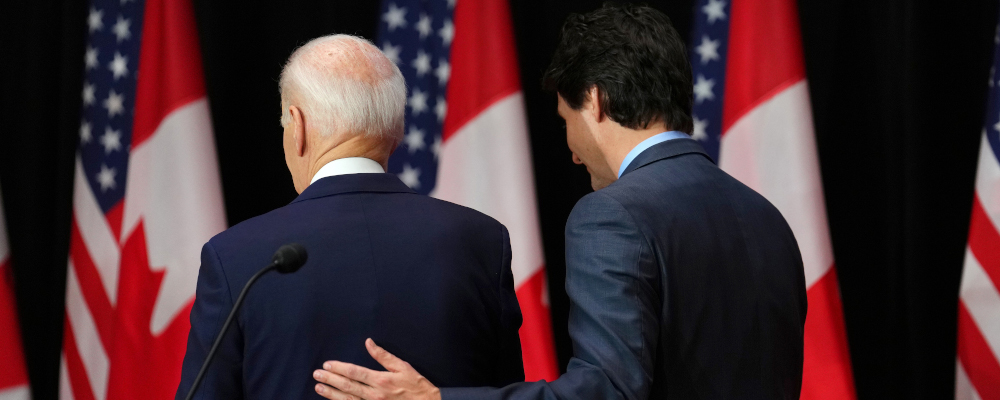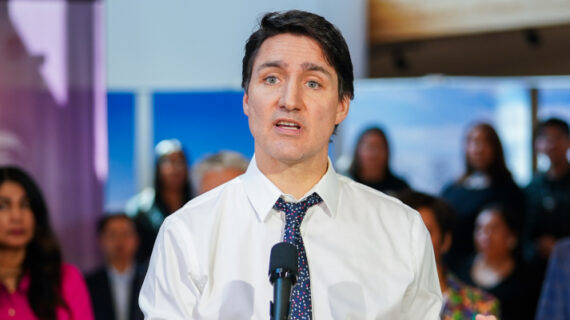- More than $2 billion worth of trade occurs between Canada and the U.S. every day.
- Donald Trump’s presidency was marked by a dramatic increase in protectionist measures against Canada. This included an initial 25 percent tariff on Canadian steel imports and a 10 percent tariff on aluminum.
- But, President Biden has also been a protectionist on trade. Experts are asking if "America First" and "Made in America" are the new normal, regardless of who's in the White House. And could Trump ramp it up even more?
After winning the Republican Party’s New Hampshire primary this week, all signs point to Donald Trump becoming the GOP’s presidential nominee for the upcoming American election. But while Canadians may have major concerns about the prospect of another Trump presidency, when it comes to trade, at least, things might actually not look so different than they do right now.
“America First” and “Buy America” may now be bipartisan and here to stay. But experts are wondering if Trump could take it even further.
It goes without saying that the U.S.-Canada trade relationship is vital. More than $2 billion worth of trade occurs between Canada and the U.S. every day. In 2022, more than 63 percent of Canada’s total trade was with the U.S., to the tune of $960 billion a year. Of all the goods leaving America, 17.3 percent are bound for Canada. That’s more than what it sends to China, Japan, and India combined.
Trump’s presidency, lasting from 2017 to 2021, was marked by a dramatic increase in protectionist measures against Canada. This included an initial 25 percent tariff on Canadian steel imports and a 10 percent tariff on aluminum.
Somewhat surprisingly, given the parties’ traditional stances on trade, President Biden has kept some of Trump’s protectionist measures, while also instituting some of his own.

“Donald Trump, Republican, he does a lot of protectionist stuff,” says Vincent Geloso senior economist at the Montreal Economic Institute. “Joe Biden comes in, Democrat, and he also keeps doing some form of protectionist policies.”
The associate professor of economics at Virginia’s George Mason University says neither Biden nor Trump are likely to curtail the growth of protectionism in the North American market.
Although at first glance Biden may appear more conciliatory towards Canada on trade issues, Geloso cautions against labelling him a free-trade president. “I just think he’s less protectionist than the other guy,” he says.
President Biden is happy to hammer home this protectionist stance in public.
“Instead of relying on foreign supply chains, let’s make it in America,” he declared during his 2022 State of the Union. “I put Make It in America at the heart of my economic plan,” he boasted on Twitter last year.
Obama poked at the free-trade consensus; Trump upended it
According to Colin Robertson, a former Canadian diplomat and vice-president and fellow at the Canadian Global Affairs Institute, the 1980s and ’90s were marked by both Republican and Democratic administrations pursuing pro-free trade policies to Canada’s benefit. The era culminated in the two countries signing the North American Free Trade Agreement, now the renegotiated United States-Mexico-Canada Agreement (USMCA).
By the time the new millennium rolled around, Robertson says President George W. Bush was just too busy coordinating foreign wars to devote much time to trade policy reform.
However, when Barack Obama entered the White House in 2009, he adopted some protectionist measures to appease his Democratic base. His American Jobs Act included a “Buy American” provision that required all iron, steel, and manufactured goods used in public building or public work projects funded by the act to be made in the U.S., with some exceptions.
Nevertheless, Robertson notes most presidents since the Second World War have generally favoured free trade over protectionism, regardless of party.
Donald Trump changed that, solidifying the nation’s collective protectionist stance. Today, both Democrats and Republicans favour greater degrees of protectionism against Canada than existed before 2016.
Xavier Delgado, a research associate with the Canada Institute at the Washington, D.C.-based Wilson Center admits there is currently little partisan divide on trade policy. He points to Biden’s choice to hold the line on many of Trump’s protectionist measures.
“Biden, for all his differences with Trump, elected to retain many of the tariffs put in place by his predecessor,” says Delgado.
Biden paused Trump’s tariffs on EU steel and aluminum imports but did not outright remove them. As of December, a new deal on the import of those products is still being negotiated, with the exemption being extended until 2025.
Delgado adds that Biden has also instituted his own protectionist measures. This includes a requirement that construction materials be mostly, or completely, American-made. Other measures have included billions in competitive subsidies for EV manufacturers that choose to build their facilities in the U.S.
Can Trump triple down on protectionism?
This year could mean our neighbours to the south doubling down even further on protectionist trade measures. Recently, Trump proposed introducing a 10 percent tariff on all foreign imports into the U.S. However, Delgado stresses it is important to exercise caution when forecasting how a second Trump term might play out when it comes to trade.
“He is notoriously difficult to predict, even despite the fact that we have four years of trade policy…to infer from,” he says. “Trump’s affinity for trade barriers is well-known, and as president, he could impose new tariffs on Canadian goods or undermine Biden-era efforts to integrate North America’s economies.”
Delgado also warns Trump’s personal feelings about Prime Minister Justin Trudeau play a big factor. Trudeau has been openly critical of Trump since the 2020 presidential election, and has recently said that a second Trump administration “would not be easy” and be “a step back”.
There are, however, some constraints at work when it comes to how far Trump can actually go.
“Broadly, given the degree of integration between the two countries’ economies, Trump would be limited in his ability to fundamentally alter Canada-U.S. trade in the long term,” explains Delgado.
Under Biden’s presidency, the U.S. has reoriented trade away from countries with authoritarian governments, such as China, and towards strategic partners and friendlier countries, such as Mexico and Vietnam. This strategy is called “friendshoring” or “near-shoring.” Given Trump’s public disdain for trade with China, says Delgado, a reversal of course is unlikely.
Congress could be another potential barrier to radical shifts in trade policy. The wishes of the White House and Congress may not always be aligned. Disunity could mean U.S. trade policy stays in stasis.
In 2015, for example, Obama ran into great difficulty when he tried to persuade a Republican-controlled Congress to vote for the Trans-Pacific Partnership (TPP). Republican legislators opposed many of the TPP’s progressive clauses on issues like environmental regulations.
“Congress plays a big role in setting the mood on trade,” Delgado says, noting that, “attitudes towards protectionism versus free trade don’t always change with the occupant of the White House.”
During the presidencies of Obama, Trump, and Biden, the party in power has rarely controlled both houses of Congress, which has created challenges for the sitting presidents.
In 2014, Obama accused the Republican-controlled Congress of filibustering more than 500 bills since 2007. Trump’s presidency was marred by gridlock in the Senate as the Democrats attempted to delay his judicial appointments. And in recent months, Biden’s attempts to pass new bills to fund Ukraine as it fights an invading Russia have been blocked by Republican senators.

Canada’s economy not fully dependent on U.S. trade policy
Regardless of the mood in the White House or Congress, Canada does have options beyond simply hoping for favourable American trade policies.
Delgado points out that Canada is the U.S.’s largest export market—a fact that allows Canada to deploy retaliatory trade measures if and when protectionist policies are enacted. This happened under Trump when the two countries became embroiled in a tit-for-tat tariff war over the president’s decision to slap tariffs on Canadian steel and aluminum imports. The impact ended up being felt on both sides of the border.
“The sword cuts both ways,” says Delgado. “Canadian goods are inputs in many U.S. supply chains, including autos and semiconductors. Trump’s steel tariffs, despite creating jobs for U.S. steelworkers, bore losses for workers in factories that used Canadian steel as a major input and broadly raised costs for consumers.”
Alternatively, Geloso and Robertson both conclude Canada could look inward and seek to improve its position through domestic policy decisions.
Geloso notes the Canadian government could consider reducing the corporate tax rate to make Canada a more attractive destination for investment.
Soon after becoming president in 2021, Biden revoked the permit for the Keystone XL pipeline effectively cancelling the project, which would have transported oil from Alberta to the U.S. Robertson says Canada has strategically erred by not building more west-to-east infrastructure that would help get its natural resources to global markets.
“I’m not just talking about oil and gas, but also our grains and foodstuffs. Because we are the fifth-biggest producer of food and we are a major producer of energy,” he says. “All the pipelines go south, and we’ve only got a couple going to the West Coast. And so, we have to take what the Americans will pay because we’ve only got one market.”




